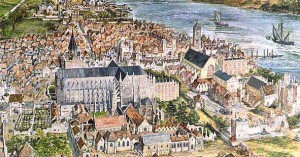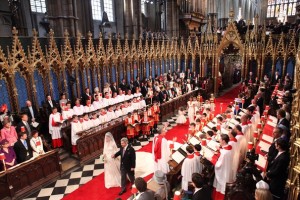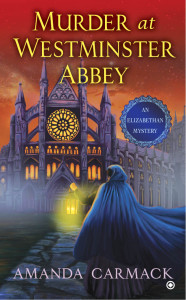I am almost done with my second Amanda Carmack mystery novel, Murder at Westminster Abbey (due–gulp!–Thursday!). It’s set around the events of the coronation of Elizabeth I on January 15, 1559, and at this point I sort of feel like I was there myself, I’ve spent so much time researching every detail. (Who wore what? How many processions were there? Who carried the queen’s cloth of gold and ermine train? Answer to the last: the Duchess of Norfolk, who was nearly knocked over when souvenir-seekers pushed her out of the way to tear up the carpet the queen walked on from Westminster Palace to the Abbey…)
Just for fun–here is a sneak peek at the cover of the book! It will be out in April 2014, and the image is still being tweaked, but you can see what it will look like…
So I thought today I would take a very brief look at the history of Westminster Abbey! It’s a vast, fascinating place, overwhelming for a history lover (Risky Diane and I once had a long, jet-lagged visit to the Abbey in a torrential rainstorm!). There are over 3000 burials there, with over 600 monuments and tablets, many to famous (and infamous) people. Over 16 royal weddings have taken place here, the most recent the Duke and Duchess of Cambridge.
 But its history started a VERY long time before Kate Middleton walked down the aisle in a Grace Kelly-esque gown. Legend has it a fisherman named Aldrich saw a vision of St. Peter on a plot of riverside land called Thorney Island (the Fishmonger’s Company still presents and annual salmon to the Abbey). In the 960s/70s, St. Dunstan and King Edgar established an order of Benedictine monks on the site, then named after St. Peter. (It eventually became known as “west minster” to distinguish it from St. Paul’s, the “east minster”).
But its history started a VERY long time before Kate Middleton walked down the aisle in a Grace Kelly-esque gown. Legend has it a fisherman named Aldrich saw a vision of St. Peter on a plot of riverside land called Thorney Island (the Fishmonger’s Company still presents and annual salmon to the Abbey). In the 960s/70s, St. Dunstan and King Edgar established an order of Benedictine monks on the site, then named after St. Peter. (It eventually became known as “west minster” to distinguish it from St. Paul’s, the “east minster”).
In 1042, King Edward the Confessor began rebuilding St. Peter’s in the Norman Romanesque style. It was consecrated on December 28, 1065, sadly just a week before the king’s death, and he was buried before the high altar. The first coronation took place there a year later, of William the Conquerer (every royal coronation since has taken place there). There is little left of the Confessor’s church now, just the rounded arches and support columns of the undercroft and the Pyx Chamber. The present church was begun in 1245 by Henry III in the fashionable Gothic style. There have been a few more additions over the years, most notably the beautiful Lady chapel of Henry VII, with its gorgeous fan-vaulted ceiling and the elaborate gilded tomb of Henry and his wife Elizabeth of York. (Elizabeth I and Mary I are buried in a side aisle of the chapel, but Henry VIII is at Windsor. His only wife buried at Wesminster Abbey is the rejected Anne of Cleves).
 The medieval monastery was dissolved in 1540, and Henry VIII erected Westminster into a cathedral church with a bishop (Thomas Thirlby), a dean and twelve prebendaries. The bishopric was surrendered on 29 March 1550 and the diocese was re-united with London, Westminster being made by Act of Parliament a cathedral church in the diocese of London. Mary I restored the Benedictine monastery in 1556 under Abbot John Feckenham. But on the accession of Elizabeth I the religious houses revived by Mary were given by Parliament to the Crown and the Abbot and monks were removed in July 1559. Queen Elizabeth I refounded the Abbey by a charter dated 21 May 1560 as a Collegiate Church, a Royal Peculiar exempt from the jurisdiction of bishops and with the Sovereign as its Visitor. In place of the monastic community a collegiate body of a dean and prebendaries, minor canons and a lay staff was established and charged with the task of continuing the tradition of daily worship (for which a musical foundation of choristers, singing men and organist was provided) and with the education of forty Scholars who formed the nucleus of what is now Westminster School.
The medieval monastery was dissolved in 1540, and Henry VIII erected Westminster into a cathedral church with a bishop (Thomas Thirlby), a dean and twelve prebendaries. The bishopric was surrendered on 29 March 1550 and the diocese was re-united with London, Westminster being made by Act of Parliament a cathedral church in the diocese of London. Mary I restored the Benedictine monastery in 1556 under Abbot John Feckenham. But on the accession of Elizabeth I the religious houses revived by Mary were given by Parliament to the Crown and the Abbot and monks were removed in July 1559. Queen Elizabeth I refounded the Abbey by a charter dated 21 May 1560 as a Collegiate Church, a Royal Peculiar exempt from the jurisdiction of bishops and with the Sovereign as its Visitor. In place of the monastic community a collegiate body of a dean and prebendaries, minor canons and a lay staff was established and charged with the task of continuing the tradition of daily worship (for which a musical foundation of choristers, singing men and organist was provided) and with the education of forty Scholars who formed the nucleus of what is now Westminster School.
A couple books I’ve used in researching the history and floorplans of the Abbey are Tony Trowles’s Treasures of Westminster Abbey (2008) and James Wilkinson’s Westminster Abbey: A Thousand Years of Music and Pageant (2003). I also watched a DVD of William and Kate’s wedding to study details of the church a little closer!
 Next week, I will share some of my research of the 1559 coronation itself, and what we might look for when it comes to the future coronations of Charles III and William V.
Next week, I will share some of my research of the 1559 coronation itself, and what we might look for when it comes to the future coronations of Charles III and William V.
Have you been to Westminster Abbey? What was your favorite site there???


I adore Westminster Abbey. I haven’t been there in a few years but when I do go, I love Poet’s Corner as well as the chapel where Elizabeth I resides opposite Mary, Queen of Scots. And I love the chapel where Henry V is buried with Catherine of Valois.
I have visited Westminster Abbey twice in my life. Once as a nine year old girl and the last time as a twenty-two year old college student. Both times I spent a great deal of time prowling Poet’s Corner and the chapel where Elizabeth I is laid to rest, as I have always admired her. I really do want to visit it again and spend more time exploring the entire abbey.
Remember our visit to Westminster Abbey? It was the first site I ever toured in England and I was enthralled by it all. I’m only sorry we didn’t figure out how to see the service and instead waiting out in the pouring rain, wet and cold.